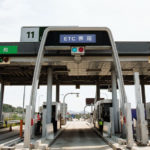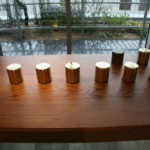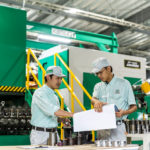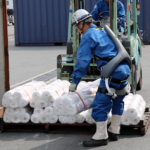Katayama Osamu visits electroplating pioneers Mitsuya Co. and finds the small and medium-sized enterprise still doing its utmost to meet all customer requests.

Kusama Seiichiro, president of Mitsuya Co.
KATAYAMA OSAMU
“If I receive a job request, I will never decline it.”
Kusama Eiichi, founding president of Mitsuya Co., made this pronouncement his company’s mission statement. Kusama Seiichiro, the current president of Mitsuya, explains his father’s policy.
“When you are busy, you tend to receive new job requests. But when you are free and have spare time, you do not receive as many job requests, which causes difficulties. As a result, the founding president told us to accept requests without fail. There are many cases where technology has flourished after people have made wholehearted efforts to respond to customer requests.”

An “image furnace” is a gold-plated light-collecting reflector that concentrates infrared light to melt solids at high temperatures. After trial and error, Mitsuya succeeded in increasing the efficiency of the device’s light-concentration and reflectivity from 87% to close to 100%. Pioneered by Mitsuya Managing Director Ozawa Shigeo, the coating technology has been used in devices for a wide range of experiments both on Earth and in outer space.
COURTESY OF NATIONAL SPACE DEVELOPMENT AGENCY OF JAPAN (NASDA)
Mitsuya found a means of survival in never declining a customer request, agreeing to tackle customer problems and solving them. As a result, Mitsuya’s technological prowess developed.
In fact, with needs for plating, including electronic parts, becoming more diverse, Mitsuya received one request after another, such as the plating of materials that were inconceivable before, including plastic and stainless steel, and the addition of new functions.
One product even flew into space aboard the National Aeronautics and Space Administration (NASA)’s space shuttle Endeavor. The project commenced from a demonstration test plan of dissolving semiconductor materials by concentrating the light of halogen lamps in space, increasing their temperature to 1,200 degrees. Mitsuya received an offer to increase the reflective efficiency with gold plating to increase the reflective efficiency of the metal reflecting mirror as much as possible for the concentration of light.
After trial and error, Mitsuya succeeded in increasing the light-concentration reflecting rate, which was usually considered to be about 87%, to more than 99.8%.
Kusama looks back on that time, saying, “The plating of a reflecting mirror is a one-shot affair. If you damage it, it is a serious problem. It’s just like treating an art item. I remember that it was really hard work.”

COURTESY OF NATIONAL SPACE DEVELOPMENT AGENCY OF JAPAN (NASDA)
The testing device that boarded the Endeavor is currently on display at the Yoichi Space Museum in Yoichi, Hokkaido, where Mohri Mamoru, who boarded the space shuttle, was born.
Nickel Plating Expertise
Mitsuya is headquartered in Gotanda, Tokyo, and there is a factory within the headquarters. Mitsuya also has factories in Hachioji, Tokyo, in Yonezawa, Yamagata Prefecture, and in Kofu, Yamanashi Prefecture. Mitsuya prides itself on its nickel plating for bonding.
For the large-scale integration (LSI) of semiconductors, LSI must be placed on a frame and silicon and metal lines must be connected by wiring. That is, wire bonding is necessary. The wire to be used for the wiring is required to be sufficiently strong in conjugation, to be mass-produced and to be low in cost. Mitsuya was asked to undertake a consultation about good gold plating that meets these requirements.
After trial and error, Mitsuya arrived at nickel plating, which is a strong field for the company.
Kusama says, “Nickel plating is an old technology. But it was intended for decoration and preventing corrosion, and it was not a high-level technology.”
Nickel plating for bonding developed by Mitsuya was outstandingly good in terms of the strength of conjugation and cost. It was also applied to other products, and its usage expanded.
For example, fundamentally speaking, for plating sensor parts for engines, non-electrolytic nickel plating was generally utilized. However, special electric nickel plating developed by Mitsuya is now a mainstream technology.
Kusama says, “The special nickel plating we developed has a global share of 40% in the market of the plating of sensor parts for engines.”

Mitsuya has provided chemical blackening treatment (center) and other plating for parts installed in many JAXA satellites over the years.
COURTESY OF MITSUYA CO.
The possibilities of plating have spread infinitely, but Kusuma is pragmatic about his company’s prospects, saying, “For the same surface treatment technology, good technologies are developed such as coating, as well as plating. In addition, we have printing technology. Completely new technology that challenges plating may emerge, such as the technology of making gold and silver particles scattered, printing like ink, adding heat and wiring. Unless you pay attention to a wide range of fields, such as competition among your competitors in the same area of business, there is even the possibility of plating itself disappearing.”
That is, it will be part of the requirements for survival to continue to meet customer requests and to continue to develop new technologies.
In the 1990s, Mitsuya established an internal technology center as part of its efforts. However, there was just one engineer in the center.
Kusama says, “After I took on the presidency, the company started focusing on technological development. Currently, we have six employees belonging to the technological center.” He goes on to say that there are thirty-four engineers who engage in quality control and environmental operations at the individual factories.
“From now on, we will be expected to work on the world of ‘nanotech,’ where even the shapes of the crystals on the surface of plating matter,” Kusama says.
The technological center is expected to play a huge role in the survival of the tough competition beyond the walls of the industry.
Expanding Overseas
Mitsuya is now focusing on developing overseas business, which it once abandoned. Although some leading plating companies have overseas bases, Mitsuya did not have such overseas bases in the past. This is because the electronic parts that Mitsuya mainly deals with are hard to present a long-term outlook for because their life cycles are short and involve numerous projects of many kinds and small amounts.
Kusama says, “It is said that you need at least 400 to 500 million yen to build overseas factories. But you cannot expect returns that are compatible with the investments. Although difficult domestic jobs remain, we find opportunities there and have taken on challenges in the domestic market.”
But there was an “incident” five years ago that triggered Mitsuya into considering launching an overseas business. Mitsuya’s communication portal received an overseas email requesting special plating. It was written in English. The employee in charge forwarded the message to the president, which caused chaos. At that time, the company had not expected to receive requests and orders from abroad.
Today, the globalization of the economy and information is extremely rapid. In this situation, information about companies with high-level technologies travels instantly around the world, even though they are small and medium-sized enterprises. In fact, there are more and more cases where Mitsuya receives questions in English from overseas companies. In addition, just like domestic cases, there are even cases where overseas companies ask Mitsuya to make model products, placing their trust in the Japanese company’s technologies.
Kusama says, “Because we cannot afford to have problems with English, we commenced English-language education for our employees. Now, our employees can easily respond to English emails from overseas clients. We are gradually receiving more orders from overseas, such as the United States and India, and we have actually commenced business with overseas companies.”

The plating line at Mitsuya Co.’s factory in Yonezawa, Yamagata Prefecture
COURTESY OF MITSUYA CO.
Mitsuya created an English version of its website and built a structure for focusing on overseas business development. Kusama says, “We have now commenced global business in Japan. Our dream is to develop our global business to the core of our business. Because the whole of Japan is implementing measures for global affairs, we also have to take proper measures for global business.”
Human Resources Development
One of the major issues for small and medium-sized enterprises is how to acquire, maintain and nurture excellent human resources. Mitsuya goes to extensive efforts to acquire and nurture human resources.
Small and medium-sized enterprises have difficulty recruiting elite students, unlike large corporations. They are required to recruit honest, enthusiastic human resources, build a system in which they can work with motivation to improve themselves and nurture them into first-rate employees.
Kusama says, “We began recruiting university graduates around 1970. Currently, we recruit about two university graduates and high school graduates each year. We have high-level plating technologies. But it is employees who used to be ordinary students who support those technologies.”
In 2008, Mitsuya introduced a career matrix system for human resources development. For this matrix structure, career posts, such as chief, team leader and section chief, are arranged on the horizontal axis and career levels, such as entry-level, mid-level and high level, are arranged on the vertical axis with a focus on career specialty. This enables employees to envisage a specific vision, such as “I am aiming to become a mid-level section chief.”
Kusama says, “For the specifics of each matrix, we laid out and identified all the details, such as what experience, knowledge and techniques are required. It was such hard work that the preparations took about three years. After the launch of the system, we had an interview with each employee every year, discussing milestones such as what level they would aim for during a specific period of time and what level they would aim for the next year in order to achieve it. We had them undergo the necessary education for step-ups.”
This is a very elaborate human resources development system. In 2011, this career matrix system was awarded the Grand Prize of the Governor Prize of Tokyo Small and Medium-Sized Enterprises’ Skill and Human Resources Development.
In addition, Mitsuya not only makes efforts to acquire excellent young human resources but also creates an environment where employees with excellent techniques and experience can work for many years.
Highly experienced craftsmen who can tell what ingredient is missing by licking plating liquids have supported Mitsuya, which has devoted itself to plating since its inauguration. Even today, when research on plating technologies has been progressing, their techniques are still said to be lumps of know-how and black boxes.
Experienced craftsmen and engineers with “tacit knowledge” are sources of the competitiveness of small and medium-sized enterprises. Accordingly, Mitsuya allows experienced engineers to continue to work for as long as they like, even after retirement age if they want to.
For example, Ozawa Shigeo is 74 years old this year, but he still continues to work as a managing director. He is a craftsman who was selected as a “modern master” in recognition of his contribution to the development and standardization of partial plating and the processing methods of a unit of one-hundredth.
But Mitsuya faces a difficult problem: plating factories have such heavy environmental loads that it is tough to take environmental measures, such as the disposal of wastewater, in urban areas. When Mitsuya tried to integrate the factory within the head office with the Yonezawa factory in Yamagata and the Hachioji factory in Tokyo with the Kofu factory in Yamanashi, many customers disagreed and prevented it.
Mitsuya has factories in urban areas with good access, which are good locations for customers to visit for consultations. Customers depend on Mitsuya that much.
Kusama says, “As long as there are needs, we want to continue with the plating business coexisting with local regions by carrying out proper environmental measures in the area where we commenced business.”
In an environment where the landscape has changed dramatically from when Mitsuya started business, plating craftsmen and engineers are still quietly brushing up their skills separately from the bustle of urban life.
KATAYAMA Osamu is an economics journalist and representative of K-Office. He has published extensively, including Sumato kakumei de seicho suru Nihon keizai (Growing the Japanese Economy with the Smart Revolution), and Naze Za Puremiamu Morutsu ha uretsuzukeru noka? (Why does The Premium Malt’s beer sell so well?). Recent publications include Samsun kuraishisu (The Samsung Crisis).








